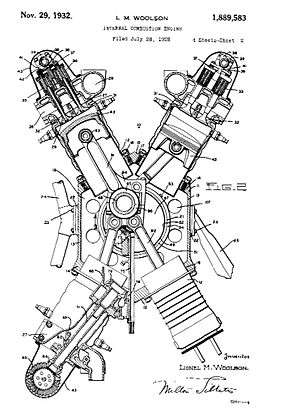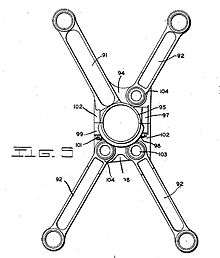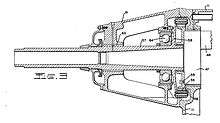Packard X-2775
| Packard 1A-2775 | |
|---|---|
 | |
| Packard 1A-2775 engine arrangement | |
| Type | 24-cylinder liquid-cooled X-configured piston engine |
| National origin | United States |
| Manufacturer | Packard Motor Car Company |
| First run | 1927 |
| Produced | 1927-1935 |
| Number built | 3 |
| Developed from | Packard 1A-1500 |
The Packard X-2775 (company designation A-2775) was an American experimental liquid-cooled aircraft engine. The engine was constructed as a single crankcase with four banks of six cylinders in what is close to an X-configuration. The engine was an upright 60 degree vee-12 and an inverted 60 degree vee-12 sharing a common crankcase. Although technically incorrect, the engine has been characterized as two Packard 1A-1500 V-12 engines coupled with a mutual crankcase.
Design and development
Packard was founded in 1899 by two brothers, James Ward Packard (5 November 1863 – 20 March 1928) and William Doud Packard (November 3, 1861 - November 11, 1923) of Warren, Ohio who ran the Packard Electric Company. In 1926 about 20 New York business men, including James Packard, and a group of US Navy officers expressed an interest in building an airplane designed to break the standing air speed record. Navy officials agreed that they would finance the proposal when funds became available. The aircraft was to be completed in time to participate in the 1927 Schneider Trophy Race, which would be held in Italy.[1]
1A-2775 Engine
The engine was designed by Navy Captain Lionel Melville Woolson, an aeronautical engineer at the Packard Motor Company of Detroit. The engine was an "X" configured design similar to one upright and one inverted V-12 engine mounted on the same crankshaft with a common crankcase. With 5.375 in (136.5 mm) bore and 5 in (130 mm) stroke, the resulting displacement was 2,775 cu in (45.47 l). The engineering involved in the design of the crankshaft, single piece crankcase and the master/slave rod system was very complex.[2]

The connecting rods were a master-slave design similar to that used on a radial engine. This resulted in the 5 in stroke becoming slightly longer in three of four banks, and resulted in slightly more displacement than the theoretical 2,722.88 cu in (44.6200 l) produced by an engine of that bore and stroke. The engine produced 1,250 hp (930 kW) at 2,700 rpm and weighed 1,402 lb (636 kg).[2]
The crank cheeks were used as main bearing journals, and were 7.75 in (197 mm) in diameter. This was necessary to keep the crankshaft length the same as the 1A-1500 engine so that 1A-1500 components could be used, and to keep the weight as low as possible. The single piece crankcase was designed to save weight and give maximum strength, but made assembly of the engine difficult. The engine was finished by August 1927.[2]
The Navy's Bureau of Aeronautics ordered a second supercharged engine under their original contract No. 3224. It was equipped with a special Roots-type supercharger. It was ordered with a supercharger when it was discovered that it would be necessary to supercharge the engine in order to equal the reported speeds of the other contestants.[2]
The Bureau of Aeronautics analyzed the possibilities of the plane becoming a competitive race plane, and decided that the extra weight of the supercharger could be better put to use by installing an epicyclic reduction gear, for improved propeller efficiency, thereby providing greater improvement in performance than what the supercharged engine with a direct drive propeller could provide for the same weight.[2]
It was further planned to increase the compression ratio of the engine, improving its performance with no increase in weight, but needed to secure dynamometer data on the supercharged engine to make a final decision. The dynomometer tests indicated the power output was only 1,300 hp (970 kW) @ 2,800 rpm due to the large impeller clearance that allowed only 7.7 in (200 mm) Hg boost. After reducing the impeller clearances, the supercharger then produced 9.6 in (240 mm) Hg of boost and the engine produced 1,500 hp (1,100 kW) at 2,700 rpm.[2]

The first engine later received an epicyclic propeller reduction gear made by Allison, an increase in its compression ratio, a Scintilla magneto ignition, and the new design cylinder banks of the 3A-1500 inverted engines, a design that had both spark plugs on the outside for easier maintenance.[2]
Official Packard photographs of this engine are marked "model 2A-2775", and photographs of the earlier versions are marked "not to be released to the press — hereafter only 2A-2775 are to be released — per Capt. Woolson." Most of the published photographs are of this engine. In spite of Captain Woolson's note, it was identified as either a 1A-2775 or the "Packard X engine."[2]
The engine was advertised as being available "built-to-order" as late as September 1930 at $35,000 each. No orders were received, and because only two engines were built, both for the Navy as X-2775s, the Packard model designation of 2A-2775 never came into public use.[3]
Engine No. 2 also received the new style cylinder banks and was tested both with and without the reduction gear. The direct drive and reduction gear units were interchangeable, and were switched between the two engines as needed.[3]
Engine No. 1 in its most modified version, with high compression, reduction gear and late type cylinder banks, was used in the Naval Aircraft Factory Mercury racing plane with engine 1A-2775, Serial No. 1, Bureau No. 10960, as a U. S. entry in the 1929 Schneider Trophy.[3]
Engine No. 1 is the only known 1A-2775 survivor and it was given by the Navy to the Smithsonian in 1971. It is in the same configuration as it was when used in the Mercury racer.[3]
2A-2775 Engine
Packard apparently built a third engine some time after 1931 when the Navy had stopped testing its engines. No photographs of this engine have been found, but engineering data dated in early 1939 show a 2A-2775 with an output of 1,900 hp (1,400 kW) @ 2,800 rpm. BMEP was listed as 196 psi (1,350 kPa) indicating the engine was supercharged.[3]
Variants
- 1A-2775 No.1
- rated at 1,200 hp (890 kW) at 2600 rpm and max of 1,250 hp (930 kW)at 2700 rpm, - Weight 1,513 lb (686 kg).
- 1A-2775 No.2
- rated at 1,400 hp (1,000 kW) at 2600 rpm and max of 1,500 hp (1,100 kW) at 2700 rpm, - Weight: 1,635 lb (742 kg) - Supercharged (1928)
- 2A-2775 No.3
- rated at 1,900 hp (1,400 kW) at 2800 rpm, - Weight: 1,722 lb (781 kg).- Supercharged (1935)
Applications
- Kirkham-Williams X
- Naval Aircraft Factory SP (aka Mercury Racer)
Survivors
The No.1 engine survives in the Smithsonian Museum collection.
Specifications (1A-2775)
Data from Neal
General characteristics
- Type: 24-cylinder, liquid-cooled, X-configured, piston engine
- Bore: 5.375 in (136.5 mm)
- Stroke: 4 in (100 mm)
- Displacement: 2,723 cu in (44.62 l)
- Dry weight: 1,635 lb (742 kg).
Components
- Valvetrain: 4-valve, overhead-cam
- Supercharger: Gear-driven supercharger
Performance
- Power output: 1,400 hp (1,000 kW) at 2600 rpm
- Specific power: .50 hp/in³ (22.753 kW/l)
- Power-to-weight ratio: .85 hp/lb (1.397 kW/kg)
References
Notes
Bibliography
- Neal, Robert J.; Packard as an Aero Engine Builder - Spark-Ignition Engines: 1923-1939 Torque Meter Vol. 7 No. 3 Summer 2008 at Aircraft Engine Historical Society
- Gunston, Bill. World Encyclopedia of Aero Engines. Cambridge, England. Patrick Stephens Limited, 1989. ISBN 1-85260-163-9
- Pakard engine statistics Aircraft Engine Historical Society